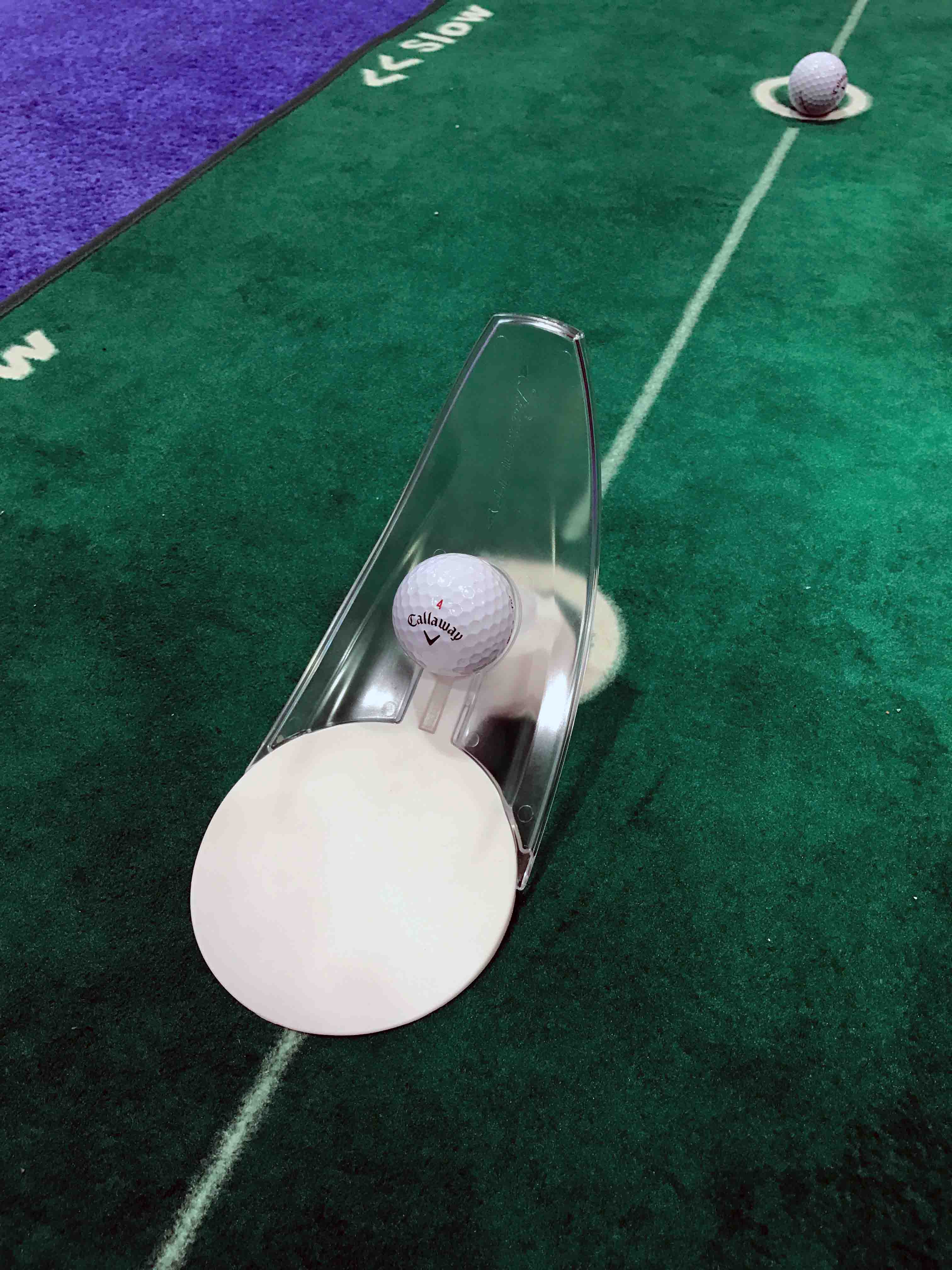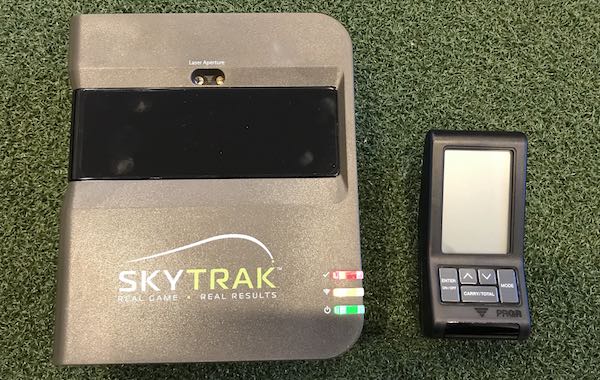
A lot of us are going to be spending more time at home than ever. In an attempt to help many of you keep busy, I created a guide with various ways you can practice golf at home. I'll focus on three main categories - putting, full shots, and wedge play. Not everyone will have the ability to work on all of these due to size constraints, but I hope that you'll get some good ideas with whatever methods you can practice. Also, I've linked to other articles I've written to help explain certain concepts in more detail.
Also, if you are interested in building a home golf simulator setup please check out my guide here.
Putting
While all of you may not be able to do each of the practice methods I'll outline, putting is the one thing that almost anyone can practice at home.
There are three critical putting skills:
- Speed control
- Green reading
- Starting the ball on your intended line (stroke quality)
Unfortunately, you can't practice all of them at home. For most of you, your best bet is going to be working on the quality of your stroke.
What You Can Use
When I was a teenager, I used to putt on the carpet in the hallway with a glass cup. There's nothing wrong with going as basic as that. A fun, rather inexpensive product, called PuttOut is also an excellent tool if you do have an existing surface and want to give yourself more of a challenge. You can read my full review here.

Many of you already have putting mats at home. If you don't, a premium option that I recently wrote about is the Perfect Practice Putting Mat. I just contacted the owners, and they have a strong supply at the moment still. You can purchase it here for a 10% discount.

Alternatively, the SKLZ accelerator is a good choice if you want to keep your cost down.
The Distances That Make a Difference
Practicing your putting inside of 10 feet is very important. These are the distances where golfers have a decent chance of making putts.
I often bring up these stats to give people perspective on putting and its difficulty:

Using these percentages as a guideline can help benchmark your progress. There are plenty of different games you can play to keep yourself engaged and challenge yourself to build your putting skills. Here are a few you can try out:
- Line up six balls roughly a foot apart. If you make the first putt, move on to the next one. Each time you miss, you have to start all over again. See if you can make it to the last putt. To add a challenge, you can keep going with the smaller hole, or add to the number of putts you have to make on each station (2, 3, or 4 in a row).
- A variation of this game is to slightly change the position (moving it to the left or right) of each ball to force yourself to re-align before the next putt.
- Pick a distance, and see how many putts you can make in a row. Have a leaderboard to keep track of your best scores from each distance.
If You've Got Some Room
Let's say you do have a stretch of carpet that is longer than 10-20 feet in your house, perhaps in your basement; you could do some speed drills. While a carpet isn't the perfect surface, it's better than nothing!
A great way to work on your speed control is to make small windows to land the ball in. For example, if you're as little as 10 feet away, you can try to keep the ball within a 6-12 inch area (you can use golf balls or coins to mark these out). As you get further away, say to 20 feet, you can expand the window to 18-36 inches based on your skill level. Try to challenge yourself with games where you have to land a certain amount of balls within the target area before you can move backward.
Here is another example of a game you can play:
Practicing Into a Net
I realize not everyone has the space in their apartment or house to hit full shots into a net. But if you do, there are plenty of ways to make this practice meaningful. I'll break this section into a few parts, depending on whether or not you have any feedback on your shots from a launch monitor. I'll also link to articles that explore each method in further detail.
If you are looking for a quality net, we recommend reading our Spornia SPG-7 review.
Impact Practice
Anyone who has read Practical Golf for any amount of time knows that I am a huge proponent of tracking your impact tendencies. This would be my number one recommendation for anyone who is hitting balls into a net at home, especially if they have no way of knowing how the shot turned out.

Where you make impact on the face of the club is crucial for the quality of your golf shots. I'd strongly recommend reading these two articles to understand why it's so essential and ideas on how to practice:
The Most Underrated Fundamental in Golf
Golf Ball Speed: The King of Distance
If you get yourself a can of Dr. Scholls Foot Spray, you can start to understand where your tendencies are, and improve them.
Tempo Practice
Another favorite practice method of mine when hitting balls into a net is working on your swing tempo. Most of the readers of this site come back to me with fantastic results when they do it.
To understand why the concept is so important, and how to practice effectively, I recommend reading my full breakdown of swing tempo here.
Low Point Control
One of the biggest challenges of practicing on synthetic turf is knowing where your club is bottoming out. A lot of times, mats can give you a false sense of confidence.
A critical skill of any ball striker is low point control. Ideally, you want your irons to make contact with the ball first, and then interact with the grass afterward on a downward trajectory. Contrary to popular belief, you don't need to "hit down on it" that much; most golfers would benefit from a relatively shallow angle of attack with their irons.
This video gives a great drill with a towel that can be performed on a mat:
Launch Monitors
Launch monitors have become a popular way to give feedback when practicing into a net. I've covered this topic extensively on the site, and many of you know that I use a SkyTrak launch monitor myself.

Whether your budget is as little as $200, or in the thousands, there are plenty of ways to use these devices to practice effectively. Here are links to all of the relevant articles I've written on launch monitors:
How to Practice With a Launch Monitor
Here are reviews of popular launch monitors:
Wedge Play
If you have a yard at your house and are willing to tear up the lawn a little bit (don't say I didn't warn you), there are plenty of ways to sharpen your wedge game. Since your lawn size will be a constraining factor, you will likely be working on shorter chip or pitch shots (read this article to see the difference between the two).

There are three skills you can work on, which primarily dictate success on the golf course:
- Distance control
- Trajectory
- Turf interaction
I'll give you a few ways to practice each of these in this section.
Distance Control
How well you can land the ball within your intended distance is perhaps the most essential wedge skill. If you can land the ball on the green and keep it there, with regularity, you will conquer one of the most significant challenges in golf - preventing bogeys and double bogeys. Of course, you want to save pars more often, but avoiding wedge shots that don't make it on the green is a skill within every golfer's reach.
So whenever you are hitting wedge shots in your yard, always have an intended target. It could be a tree, a bucket, or even a baseball cap. If you want to put pressure on, just put one of your kids out there and try and land the ball just short of them (I'm kidding). Overall, you can't hone your distance control unless you are actively trying to land the ball within a reasonable distance around your target. Also, don't expect perfection.
I also prefer simplicity when it comes to wedge play. Get good at controlling your distance with only one or two wedges, so you know what to expect on the course. I do 95% of my practice on these shots with my 56-degree and 60-degree wedges.
Lastly, you should mix up your practice between repetitive and random targets, which I discussed in this post recently. Here are a few examples:
- Choose one target and hit 5-10 balls repeatedly, paying close attention to the overall proximity. Keep track of your progress and get competitive with yourself.
- Play a game of "leapfrog." Hit the first shot to a shorter distance, and then try and progressively land the next series of balls one step farther than the last. You can also do this in reverse order.
- Randomly test yourself. Set up 4-5 targets around your yard at various distances and randomly cycle through them.
Trajectory
How low or high your wedge shots travel through the air is also very important for scoring. As you have noticed, a shot on a lower trajectory tends to roll out more on the green, whereas a higher-lofted shot will stop a little faster.
Without getting too complicated, there are two primary ways to control your trajectory. The first is with club selection. All things being equal, chipping with an 8-iron will get the ball started on a lower trajectory versus a sand wedge. The second way to control trajectory involves how you deliver the club. Some players are more skilled at using their hands and set up to add or decrease loft with the same club.
I believe loft control is an area of wedge play where a little experimentation can help most players. What I like to do is pick a target and try to land the ball at the same distance with a low, medium, and high trajectory. You can do this with the same club, and experiment with ball position, opening or closing the face, or altering your technique. Conversely, you could also choose different clubs to achieve those different trajectories. Going through this exercise will give you a better sense of what's required to keep the ball a little lower or higher.
My only warning is that you don't need to get too fancy with things. For the most part, you can hit very similar wedge trajectories and get good results on the course. Phil Mickelson flop shots aren't required. But experimentation is a very helpful exercise to build your skills, which will make you more proficient on your "stock wedge shots."
Turf Interaction
Another critical wedge skill is reading your lies. Not every ball will be sitting perfectly in the fairway. When your ball lands in the rough, you'll be dealing with a spectrum of lies ranging from buried to being "fluffy" and on top of the grass. Your technique and club selection need to adjust accordingly.
Your yard might suffer a little bit, but if you are willing, you can experiment with different lies and see how the club reacts. A general rule of thumb to go by is the following:
If your ball is buried, it's best to get a little steeper with the delivery of the club. Think of it like a plane that is taking a nosedive. Also, use a club with more loft and bounce (like your sand wedge). You want to limit the amount of time the golf club interacts with the grass because it will slow your club down and twist the face, making it harder to control distance and trajectory.
Conversely, if your ball is laying up nicely on top of the grass, you can do the opposite. Instead of the imaginary plane making a steeper descent, you can make a more shallow approach to the ball, like a gentle landing on the runway. Sometimes I like to think of it more as a putting stroke and just gently rock my torso back and forth without engaging my hands much.
This is another area of wedge play where experimentation pays off. Give yourself a variety of lies, and see how slightly altering your technique or club selection can change your results. When you're presented with those lies on the course, you'll have a much better understanding of how the ball will react, and how to play those shots.
Wrapping It Up
I'd love for you to contribute any fun ways you've managed to practice at home, so please feel free to add them in the comments section below.
We care about the protection of your data Read our Privacy Policy